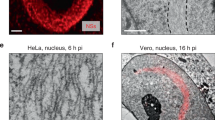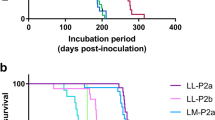Abstract
Cerebral β-amyloidosis is induced by inoculation of Aβ seeds into APP transgenic mice, but not into App−/− (APP null) mice. We found that brain extracts from APP null mice that had been inoculated with Aβ seeds up to 6 months previously still induced β-amyloidosis in APP transgenic hosts following secondary transmission. Thus, Aβ seeds can persist in the brain for months, and they regain propagative and pathogenic activity in the presence of host Aβ.
This is a preview of subscription content, access via your institution
Access options
Subscribe to this journal
Receive 12 print issues and online access
$209.00 per year
only $17.42 per issue
Buy this article
- Purchase on Springer Link
- Instant access to full article PDF
Prices may be subject to local taxes which are calculated during checkout


Similar content being viewed by others
References
Jucker, M. & Walker, L.C. Nature 501, 45–51 (2013).
Meyer-Luehmann, M. et al. Science 313, 1781–1784 (2006).
Eisele, Y.S. et al. Science 330, 980–982 (2010).
Langer, F. et al. J. Neurosci. 31, 14488–14495 (2011).
Eisele, Y.S. et al. Proc. Natl. Acad. Sci. USA 106, 12926–12931 (2009).
Fritschi, S.K. et al. Acta Neuropathol. 128, 477–484 (2014).
Prusiner, S.B. Annu. Rev. Genet. 47, 601–623 (2013).
Aguzzi, A. & Falsig, J. Nat. Neurosci. 15, 936–939 (2012).
Morales, R., Callegari, K. & Soto, C. Virus Res. 207, 106–112 (2015).
Büeler, H. et al. Cell 73, 1339–1347 (1993).
Prusiner, S.B., Groth, D., Serban, A., Stahl, N. & Gabizon, R. Proc. Natl. Acad. Sci. USA 90, 2793–2797 (1993).
Sailer, A., Bueler, H., Fischer, M., Aguzzi, A. & Weissmann, C. Cell 77, 967–968 (1994).
Rupp, N.J., Wegenast-Braun, B.M., Radde, R., Calhoun, M.E. & Jucker, M. Neurobiol. Aging 32, 2324.e1–2324.e6 (2011).
Stalder, M. et al. Am. J. Pathol. 154, 1673–1684 (1999).
Mackenzie, I.R., Hao, C. & Munoz, D.G. Neurobiol. Aging 16, 797–804 (1995).
Probst, A., Basler, V., Bron, B. & Ulrich, J. Brain Res. 268, 249–254 (1983).
Safar, J.G. et al. J. Gen. Virol. 86, 2913–2923 (2005).
Jack, C.R. Jr. & Holtzman, D.M.B. Neuron 80, 1347–1358 (2013).
Jansen, W.J. et al. J. Am. Med. Assoc. 313, 1924–1938 (2015).
Thal, D.R., Rub, U., Orantes, M. & Braak, H. Neurology 58, 1791–1800 (2002).
Calhoun, M.E. et al. Proc. Natl. Acad. Sci. USA 96, 14088–14093 (1999).
Eisele, Y.S. et al. J. Neurosci. 34, 10264–10273 (2014).
Maia, L.F. et al. Sci. Transl. Med. 5, 194re192 (2013).
Acknowledgements
We would like to thank L. Goepfert and T. Joos (NMI, Reutlingen) and M. Hruscha, M. Lambert and L. Haesler for help with the immunoassays, A. Bosch, C. Krüger, J. Odenthal and all of the other members of our department for experimental help, and C. Haass (Munich) for antibody donation. This work was supported by grants from the Competence Network on Degenerative Dementias (BMBF-01GI0705) and the EC Joint Programme on Neurodegenerative Diseases (JPND-NeuTARGETs). L.Y. was supported by a Chinese Scholarship Council grant for PhD scholarship.
Author information
Authors and Affiliations
Contributions
L.Y., S.K.F., J.S. and U.O. performed the experimental work. L.Y., S.K.F., J.S., U.O., K.D., S.A.K., F.B. and M.J. carried out the analysis. Experimental design and preparation of the manuscript was done by L.Y., S.K.F., Y.S.E., L.C.W., M.S. and M.J.
Corresponding author
Ethics declarations
Competing interests
The authors declare no competing financial interests.
Integrated supplementary information
Supplementary Figure 1 Ultra-sensitive bead-based Simoa technology detects residual human Aβ in hippocampal extracts of inoculated App−/− mice.
Aβ seed-containing APP23 brain extract or seed-negative WT mouse brain extract was injected into the hippocampus of App−/− mice. The injected hippocampi were isolated 1, 30, 60, or 180 dpi (see Figures 1 and 2). While ECL-linked immunoassay no longer detected any Aβ at and beyond 30 dpi (Figure 1), the bead-based Simoa technology detected human Aβ up to 180 dpi. Note that the majority of Aβ was cleared within the first 30d with much slower clearance of residual Aβ thereafter. (The same samples were analysed as in Figures 1 and 2, thus n = 6, 10, 5, and 5 for 1d, 30d, 60d, and 180d, respectively). One-way ANOVA for the APP transgenic extracts revealed F(3,22) = 8.932, P = 0.0007. Bonferroni post hoc test for pairwise comparisons, **P<0.01, ***P<0.001. WT-injected mice (n = 4; 30 or 60 dpi).
Supplementary Figure 2 Induced amyloid lesions are partly congophilic and surrounded by activated microglia and dystrophic boutons.
(a) Congo red-positive amyloid deposits induced in the dentate gyrus were surrounded by Iba1-positive microglia (black). (b) Congo red-positive plaque with surrounding hypertrophic microglial cell bodies and processes at higher magnification. (c) APP-immunoreactive dystrophic processes and boutons (black) in close proximity to a congophilic amyloid plaque. Images are from a 1 or 30 dpi App−/− hippocampal extract-inoculated APP23 mouse. Scale bar: 100 μm (a), 20 μm (b,c).
Supplementary Figure 3 Cerebral amyloid angiopathy (CAA) was always induced in addition to parenchymal amyloid.
(a) Shown are the Aβ-immunostained and Congo red-stained hippocampus and thalamus of an APP23 mouse that had been inoculated with a 30 dpi App−/− hippocampal extract 8 months earlier. Note the prominent CAA in the thalamus (asterisk). Scale bar: 200 μm. (b) Perl´s Prussian blue staining of an adjacent section reveals multiple microhemorrhages in the CAA-laden thalamic region (arrow). Insert shows the microhemorrhages at higher magnification. Scale bars: 200 μm and (inset) 50 μm.
Supplementary information
Supplementary Text and Figures
Supplementary Figures 1–3 (PDF 1022 kb)
Rights and permissions
About this article
Cite this article
Ye, L., Fritschi, S., Schelle, J. et al. Persistence of Aβ seeds in APP null mouse brain. Nat Neurosci 18, 1559–1561 (2015). https://doi.org/10.1038/nn.4117
Received:
Accepted:
Published:
Issue Date:
DOI: https://doi.org/10.1038/nn.4117
This article is cited by
-
Long term worsening of amyloid pathology, cerebral function, and cognition after a single inoculation of beta-amyloid seeds with Osaka mutation
Acta Neuropathologica Communications (2023)
-
Experimental evidence for temporal uncoupling of brain Aβ deposition and neurodegenerative sequelae
Nature Communications (2022)
-
Remodeling Alzheimer-amyloidosis models by seeding
Molecular Neurodegeneration (2021)
-
Transmission of cerebral amyloid pathology by peripheral administration of misfolded Aβ aggregates
Molecular Psychiatry (2021)
-
Mechanism of Cellular Formation and In Vivo Seeding Effects of Hexameric β-Amyloid Assemblies
Molecular Neurobiology (2021)



